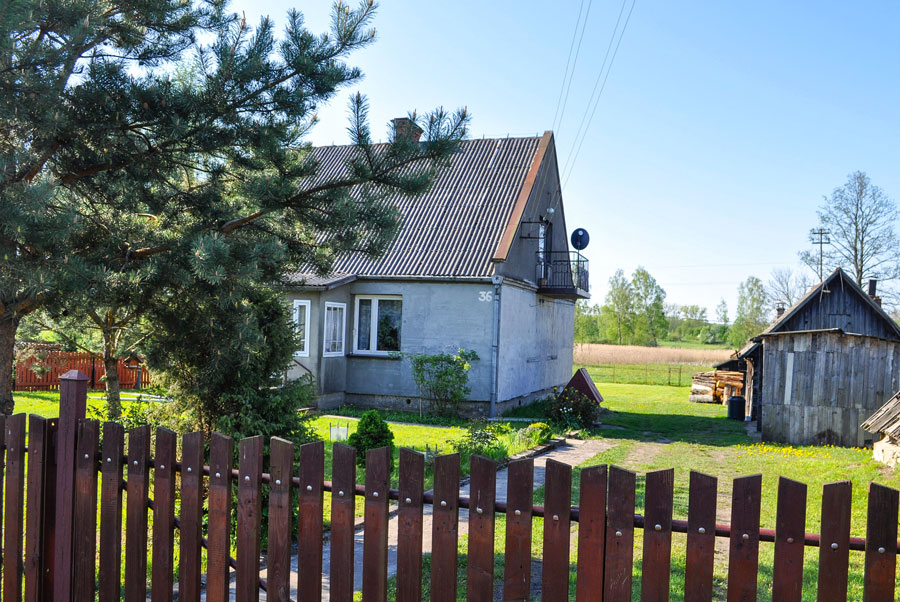The School
Before the First World War in Białowieża there was a cheder – a Jewish school for the youngest boys. This fact is mentioned in the Pinkas HaKehilot [1]. We don't know whether the cheder had a separate building, probably the lessons took part in the synagogue which in the tradition of Judaism has many functions, among which the scholar one. After the war, education was held also for older children. On the farewell letter to Aaron Feldbaum in 1921 Benjamin Hoffman signed himself as a szames (scholar) in a Bet-HaMidrasz [2]. A szames was a helper in the synagogue and in the Jewish school, whose function was to assist the teacher and spread the announcements of the Jewish community. He was also the one to call for the prayer. Pinkas HaKehilot states that some of the children attended private lessons with the melameds. [2]
Between 1936 and 1938, a seperate big building was built behind the synagogue, designed to fit the school. The building was wooden and had few floors. Jan Sawicki recalls: „Only the frame was built [until] the war, but it was never finished. (…) They didn't make it on time.... And the building was beautiful. On the foundament, tall, with an entry from the road and another one, somewhere from the north. (…) The southern part was partially finished. There were some windows". Sawicki recalls that before the school was built, the children gathered to learn in the square behind the synagogue and they walked somewhere, but he doesn't know exactly where. [3] On the other hand, Zina Buszko, who lived close to the synagogue as well, on the other side of the Stoczek street, remembers that the building was opened before the war: „The school was big. Our Chaimek used to go there [Chaim Kreszyn, the son of the hairdresser which rented half of the house from Zina's family]” [4]. Chaimek was too young to go to the public school, which means that he attended the cheder in the Jewish scholar system. Probably the building also had a school for the older students, as it was big enough.
During the Soviet Occupation of WW2, when the Russians liquidated all of the private craft houses, a cooperative was established in the southern part of the building: „That's where they fixed the shoes and did some frames, they framed cut glass” [3]. According to the testimonies collected by Piotr Bajko [5] and the testimony of Zina Buszko [4] it appears, that the wood from the deconstructed Jewish school was sold to build an primary school in Teremiski, a nearby village. Currently, the Jan Józef Lipski Common University in Teremiski is located in the building of that school. On the other hand, Jan Sawicki and Bolesław Rychter say, that it was the wood from the deconstructed synagogue that was used to build the school in Teremiski [3; 6]. But Włodzimierz Dackiewicz precisely describes the synagogue deconstruction, pointing out who took the wood for private means, which proves the theory that the Teremiski school was built with the wood from the deconstructed Jewish school.
Except for studying in the cheder and taking private lessons with the melameds [1], the Jewish children attended the public schools together with the Belorussian and Polish children. During the First World war they went to the German school established by the occupant, during the interwar period to a Polish school [1]. The old inhabitants remember it this way:
Włodzimierz Dackiewicz: „There was a lot of Jews. There were two girls studying with me, very well-behaved. (…) I was sitting sharing a desk with a Jew girl, Irena Tabacznik, in the first and second grade. She was very pleasant, (…) dark, (…) pretty, brunette, beautiful girl, womanly, curvy (…), she was like an artist. (…) Her father had a store with household goods, and not only – you could buy a bike there, and a sewing machine, you could buy everything there. The other girl was called Jabłonowicz: Jabłonowicz, a saddle-maker, Jew, his house, very big and pretty stands in the centre of Białowieża, on the left side if you go to the church. He was a very good saddle maker, his daughter went to school with me as well, (…) slim, tall.” [7; 8; 9].
Borys Russko from Podolany says: „When I was in school in Białowieża I was learning together with Jewish kids, there was more of them there [than in Podolany]” [10]; and Bolesław Rychter recalls: „The Jews were learning with us, but when we were playing games, they were separate.” [6].
During the soviet occupation on the area taken by Russians there was a liquidation of the Jewish communities (the Council), taking care of the religious education, synagogues, cemeteries and charity before the war [11]. The Białowieża cheder was probably closed as well. The Polish school in which Belorussian, Polish and Jewish children were studying together was closed as well, and how Olga Szurkowska recalls, the school was divided – the Jewish and the Belorussian children were put in one Russian school, and the Polish children could join the Polish school run by a catholic priest [12].



